Softbox or Umbrella for Product Photography? Choose the Best One!
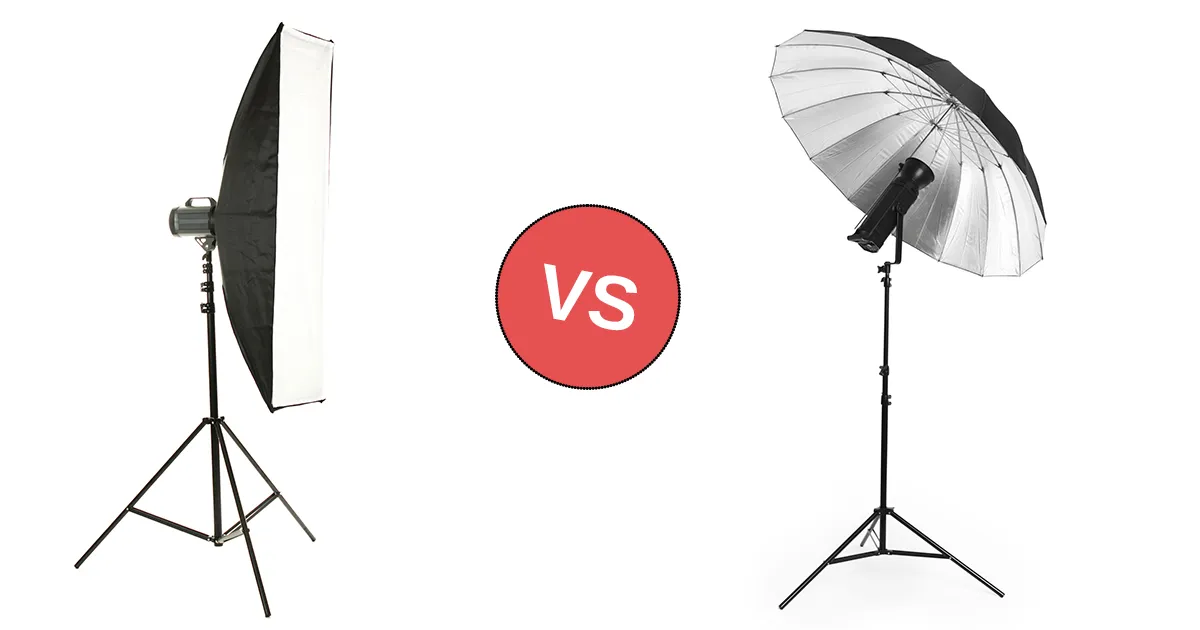
Have you ever tried to capture a photo of anything that you want to sell, but the image came out dark or just plain boring to upload online? Trust me, you're not alone in this!
Almost 90% of online shoppers agree that product pictures are a crucial factor that affects their choice to buy online.
So, the proper lighting certainly plays a critical role in your online business.
If you look up how to light your photos, you’ll see two main choices: softbox or umbrella. Certainly, both sound great and will make your pictures look absolutely great. But which one can provide the best light for product photography umbrella or softbox?
So things get tricky here, and in case you choose the wrong one, your product might look like a selfie you took in your closet: too plain and dull.
But don't worry! You can figure this out as this blog will break down the differences between softboxes and umbrellas, and once you're done, you'll know which one can make your products look their best.
Are you ready to solve the mystery? Let's get started!
Understanding the Basics of Product Photography Lighting
Let’s be honest here, you need to know the lighting basics for your products to look more professional online. Perfect lighting brings out the best of any product's features by making it more interesting to buyers.
You may use LED lights, an umbrella, fans, softboxes, and even sunlight from a window. The main light, also called the "key light," is usually placed at an angle to bring out the best features of the product. A second light, often called the "fill light," can smooth any harsh shadows. Also, backlight can give your item depth and help it stand out from the background.
Using the best softbox for product photography will basically help to spread the light evenly and get rid of bright spots or shadows if you are taking a picture of a shining watch. Whereas, if you're taking pictures of a warm sweater, side lighting will bring out the grain of the fabric. Any kind of product photoshoot, through umbrella or softbox, can give your products a better and natural look. Even with just one light and some creativity, you can get great effects.
Mainly, a good photography lighting arrangement makes your overall product photography setup look better and gives customers more faith in what they see. So, try to use different lights and angles on your goods until they really shine.
The Importance of Good Lighting in Product Photography
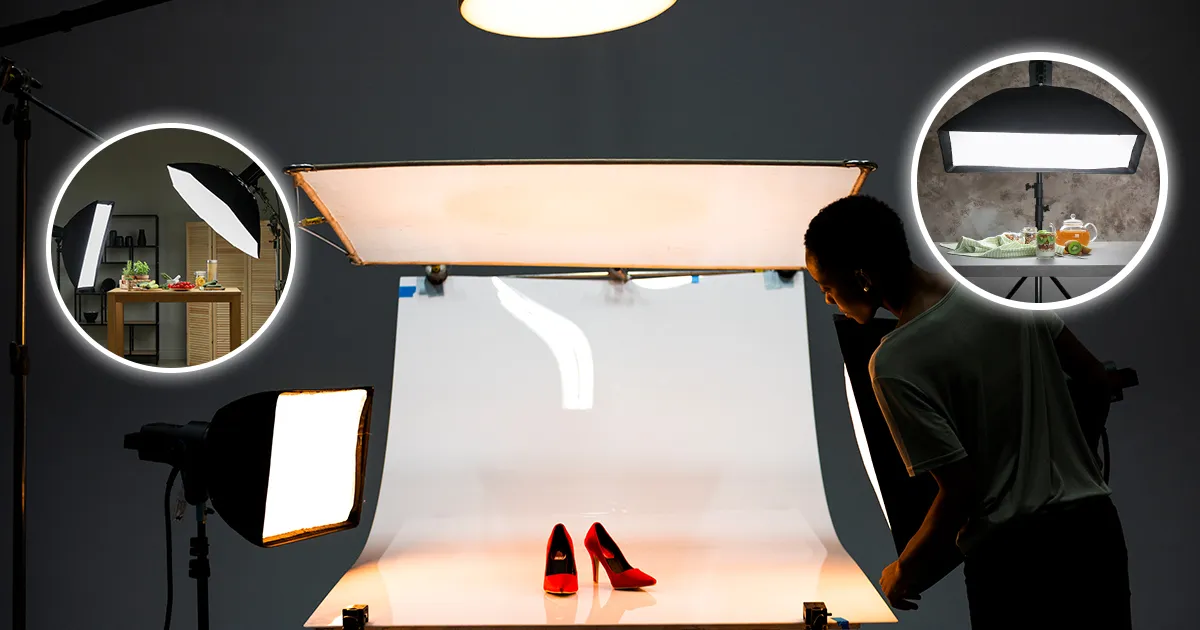
In e-commerce business, good lighting is essential from different perspectives, like outdoor, studio, or creative portrait photography. Proper lighting can show buyers the actual colors and details, which can simply increase sales. So here are the major reasons for considering the right lighting for your product photos:
- Provide Original Colors: With a good lighting setup, your product's colors will appear to be more natural and bright, so shoppers will get exactly what the product looks like online.
- Builds Trust: Photos that are clean and well-organized simply make people feel confident about buying, as they can see everything clearly.
- Highlights Details: Light brings out the unique shape, color, and style of your goods, which simply makes your product unique.
- Less Editing Time: When lighting is properly organized, you don't really have too much left to fix, so you have to spend less time editing your product photos.
- Give A Professional Look: Using consistent lighting in all your product photos helps your online store look organized and trustworthy.
- Produce Moods: Based on how the professional utilizes it, lighting can make products look warm, lively, or cozy, especially when this happens in fashion photography.
- Boosts Sales: Studies show that better product photos can increase sales by up to 25%. So, perfect lighting can simply make this happen.
Softbox
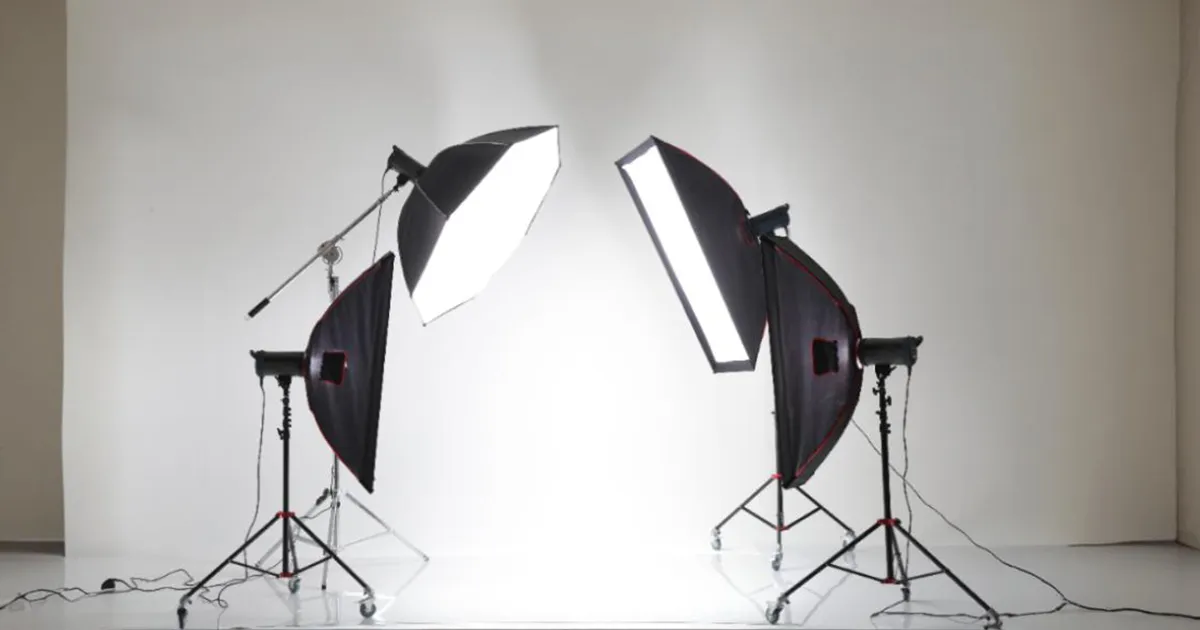
A softbox mainly looks like a light with a big white box on top of it. Photographers really love to use softboxes to make the light softer and more even on their products.
The best thing about a softbox is that it spreads the light out equally, especially if you are doing outdoor photography where sunlight is coming without any control. They come in various sizes and shapes, but all are responsible for making pictures look better by blending the actual light.
Even professional product photographers are comfortable with softboxes as they get more control over how the light hits their subject. So, if you want your product photoshoots to look professional, clear, and free of uneven shadows, a softbox can be your new best friend.
To know how to use a softbox and which one to pick, keep reading for all the details!
Different Types of Softboxes for Product Photography
I assume you’re quite familiar with the softboxes used by photographers. But did you know that there are different kinds of softboxes, each with its own use? To make it clear for you, let's talk about the most popular types -
Rectangular Softboxes
Most people use these softboxes, which look like big squares. Products like shoes, bags, and tools look great when they go through packshot photography, as the light spreads out evenly over a large area. If you’re taking a photo of a pair of sneakers for an online store, a rectangular softbox will help show off every detail without harsh shadows.
Square Softboxes
There are square and rectangular softboxes, but square ones are just that—square! They are often used for accessories photography or makeup close-ups, or shots of smaller items. As they're small, they work well in workshops and other small rooms.
Lantern Softboxes
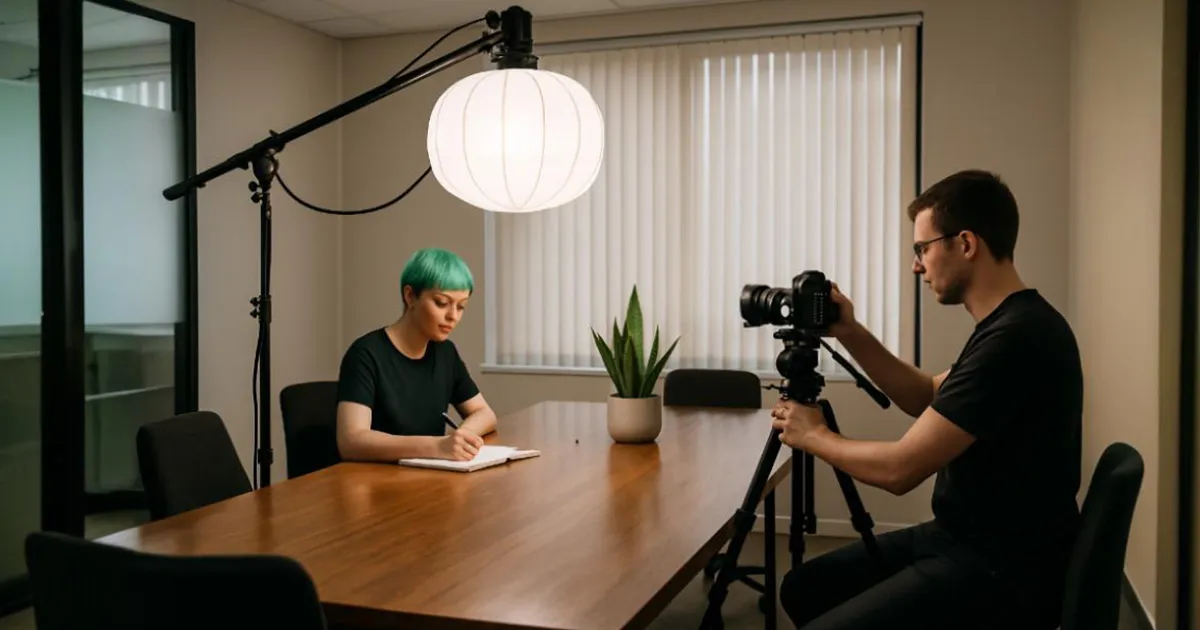
Hard boxes in the shape of lanterns; the reason why they are known as lantern softboxes. A lantern can be one of the best softbox for product photography to ensure each item is evenly lit, especially in a group of items. They give off the same lighting effect in all directions to make up a room or scene as a whole.
Strip Softboxes
Softboxes that look like strips are long and thin. They're great for giving things highlights or edge lighting, which helps set the item apart from the background. Imagine taking a picture of a tall bottle of perfume, and a strip softbox is used here. You can get a beautiful line of light along the side, making the bottle look sleek and stylish.
Octagonal Softboxes (Octaboxes)
These softboxes are shaped like an octagon and are loved for the natural glow feature. You may use them to shoot food or beauty products that need to look soft and appealing. Let’s say if you want to take a picture of any tasty cake, an octabox can give it a soft, glowy vibe that will make your mouth water.
Parabolic Softboxes
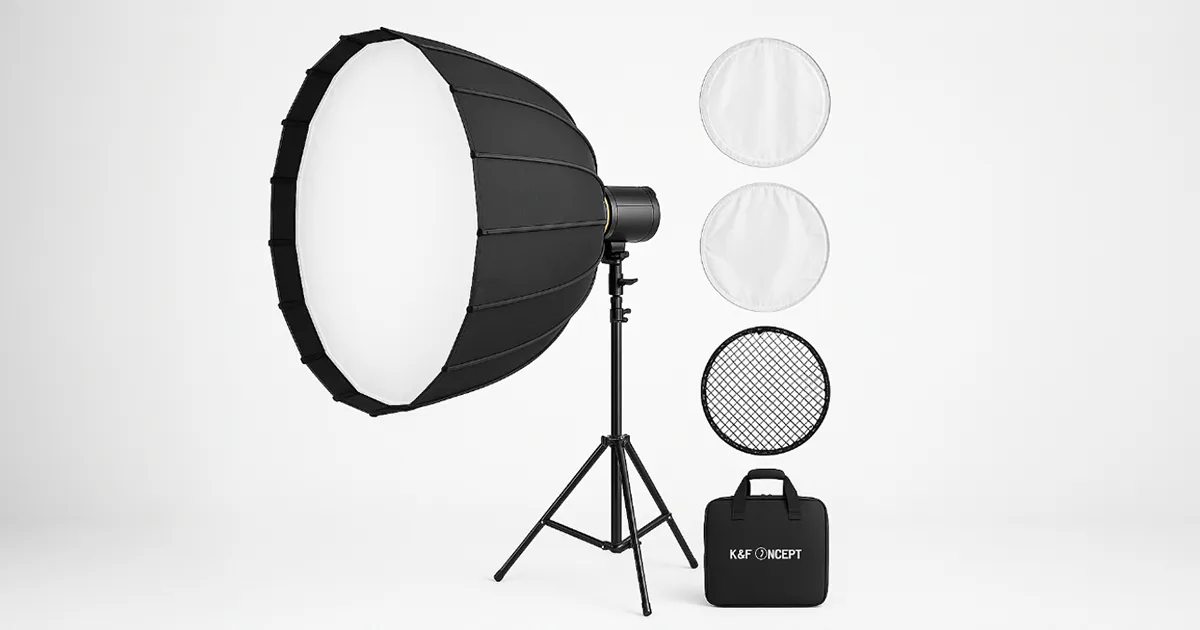
Deep and round-shaped parabolic softboxes are one of the best softbox for product photography that focus light more directly on the subject. These softboxes work well for bigger items or when you want to draw attention to textures. People also like to use these softboxes for fashion and portrait photos because they get rid of shadows and make everything look smooth.
Pros and Cons of Using Softboxes in Product Photography
Softboxes are widely used as they can provide clean, controlled lighting that brings out the best in products. However, it has some good and bad sides, just like any other tool. So here are the pros and cons of softboxes to help you decide if they are right for you or not.
| Pros of Softboxes | Cons of Softboxes |
|---|---|
| It makes light that looks natural and is soft and even. | It could be heavy and hard to move around. |
| Offers great control over the direction of light. | Takes longer to set up compared to an umbrella |
| Reduces harsh shadows and glare | Costs more than umbrellas most of the time |
| Great for product and portrait photography | Needs more space in small studios |
| Lessens unwanted reflections on shiny items | Might need to know more about lights to get the best results |
| Can be used with grids for extra control | Not ideal for broad, even lighting of large scenes |
| Helps highlight product details clearly | Some models are difficult to assemble/disassemble |
Umbrella Lights
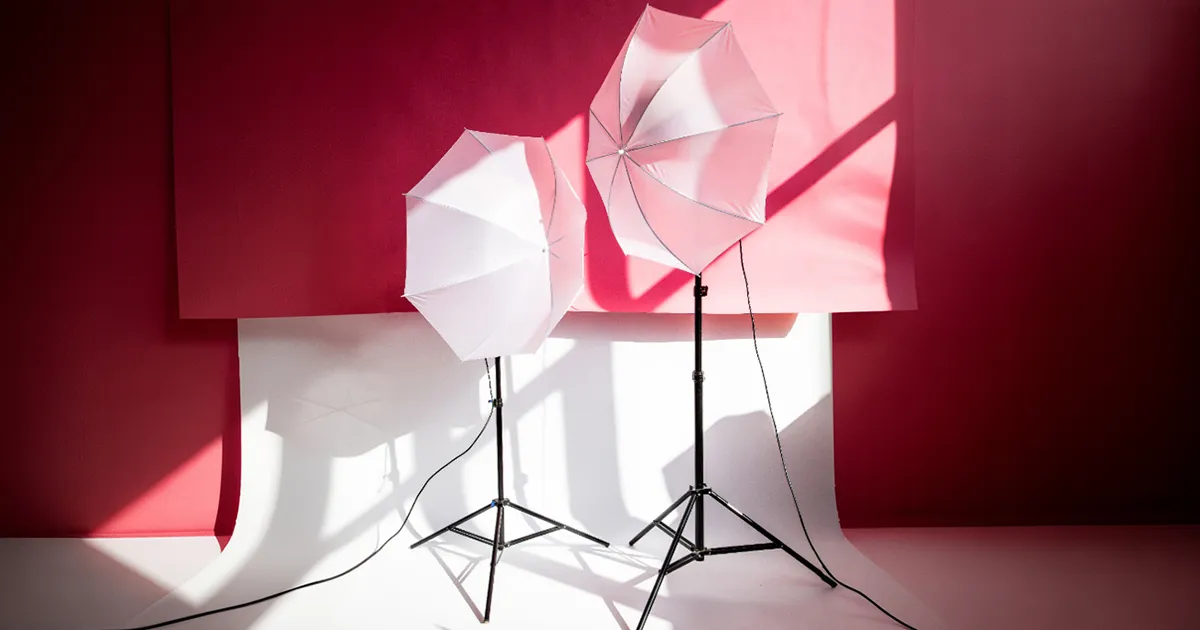
Umbrella lights in the studio photoshoots basically assist in gently and equally distributing light over your subject. They are perfect for enhancing the brightness and natural kind of appearance, just like turning a flashlight into a large, sunny window. Professionals appreciate them as they are quite simple to operate.
Umbrella lights are also incredibly portable and reasonably priced; you can carry them anywhere and put them up fast. For instance, you can just simply throw up an umbrella light to capture a box of cupcakes for your bakery site and obtain soft, mouth-watering photos without any complex shadows.
Mainly, an umbrella light is an amazing, easy, and budget-friendly choice to make your product photos look professional. Let’s learn more about umbrella lights in the next sections!
Different Types of Umbrella Lighting
There are different kinds of umbrella lights available, and each one is used for a different purpose, mainly based on the product type. Now let's break down the main groups in umbrella lighting and look at how they can help you get great pictures -
Shoot-Through Umbrella
This type of umbrella is made of white fabric that can be seen through. It goes between your light source and softens any harsh shadows. A shoot-through umbrella lighting turns the product smooth and clear in photos, whether you're taking pictures of a glass jar or a shiny phone. They are very popular with beginners because they are easy to use and give off a nice, soft light.
Reflective Umbrella
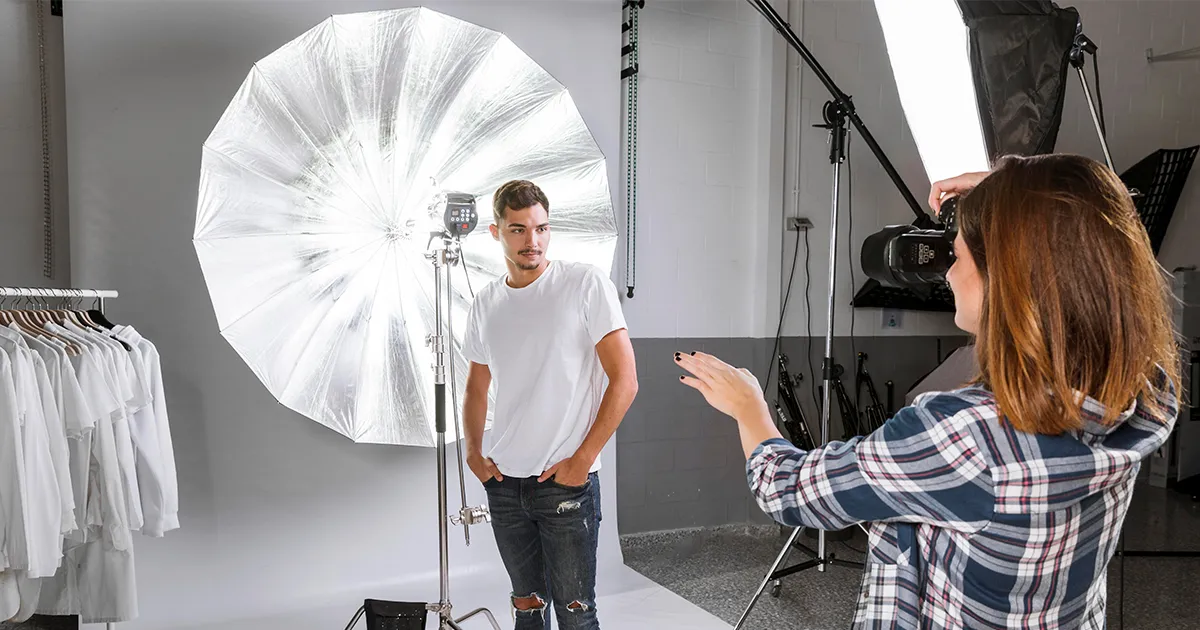
Reflective umbrellas have a black outside and a silver or gold inside that sparkles. The light hits the inside of the umbrella and bounces back onto your goods instead of shining through them. Silver umbrellas give off bright, clear light that brings out the colors in things like electronics or jewelry. Gold umbrellas give off a nice, sun-kissed glow that would make food or beauty products look better. When you want your product to stand out, reflective umbrellas are great because they let you control which way the light goes.
Parabolic Umbrella
A parabolic umbrella is deeper and wider than a regular umbrella. They focus the light into a stronger beam to make it look like natural sunlight and bring out small details on your products. A parabolic umbrella can help bring out every detail in pictures of things with a lot of texture, like a knitted basket or a high-end bag. Professionals who want intense lighting with lots of contrast often use them.
Umbrella Softbox
The umbrella softbox is a mix between a softbox and an umbrella. It opens up like an umbrella, but there is extra fabric around the sides to keep the light inside and smooth it even more. This type is great for getting smooth, even light on things like clothes or home decor, and it sets up pretty fast. It’s a handy choice if you want both the softness of a softbox and the convenience of an umbrella.
Convertible Umbrella
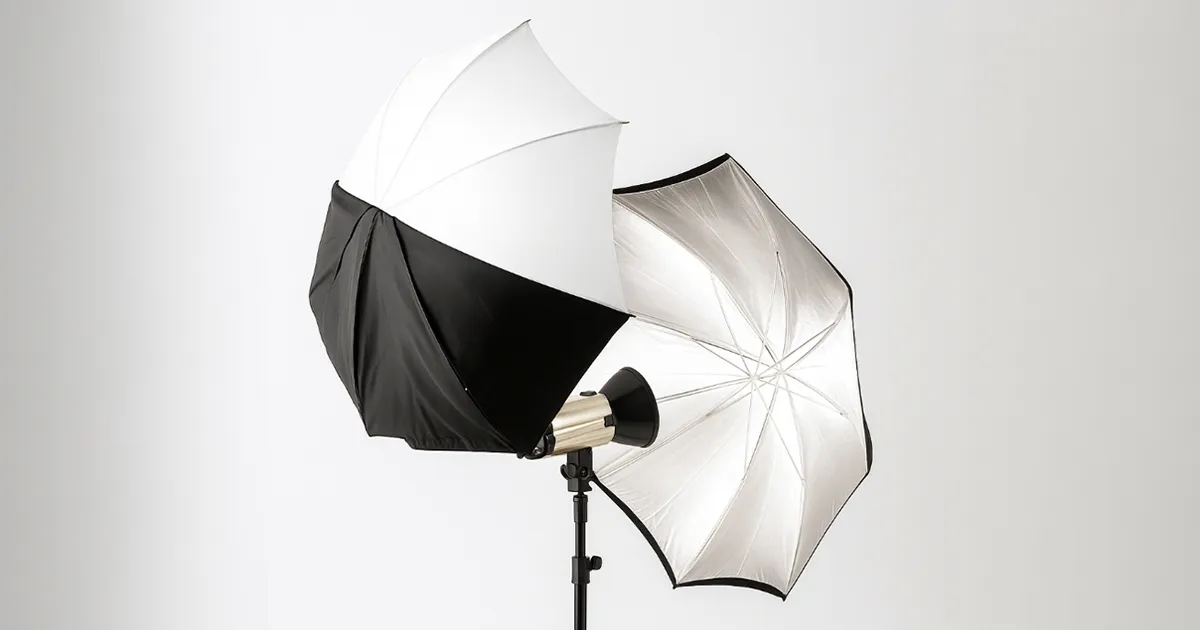
If you can’t decide between a shoot-through and a reflective umbrella, a convertible umbrella is the answer. It usually has a removable black cover, so you can use it as either type. Basically, it's a flexible and inexpensive option for you to try out various lighting methods in your product photos.
Pros and Cons of Using Umbrella Lights in Product Photography
Umbrella lights are quite a popular and budget-friendly option in product photography, but are they the right fit for all your needs? Let us look at the pros and cons of umbrella lighting to help you decide if you should buy one or not.
| Pros of Umbrella Lights | Cons of Umbrella Lights |
|---|---|
| For a realistic look, it spreads out and softens light | Harder to control light direction; more light spill |
| Easy to set up and very portable | Not as adaptable as softboxes; fewer modifiers available |
| Affordable and budget-friendly | Can create unwanted reflections or glare on shiny products |
| Fills large spaces with light | May cause tricky or harsh shadows in some setups |
| Great for beginners and quick shoots | Less power efficiency with shoot-through umbrellas |
| Works with many types of lights | Not ideal for small studios due to uncontrolled light spread |
Which is Better Softbox vs Umbrella Lighting for Product Photography?
Both softboxes and umbrellas can help your products look great but the best choice depends on your business goals and setup. But which one is the best softbox or umbrella for product photography? Let’s compare both and find out what works best for you!
Focused and Professional Softbox
Softboxes mainly focus light in a soft way that your product photoshoots can stands out without any sharp shadows or bright spots. Firms like Apple use softboxes a lot to make their items look clean and sharp in pictures. So if you want constant, high-quality pictures for your website or ads, this lighting is great.
Unfortunately, softboxes might cost more and take longer to set up. Not only that, but they need more room, so they work best in a studio. However, if you have the money and want shots that look clean and professional, softboxes are a great choice.
Simple and Budget-Friendly Umbrella
Umbrella lights spread light over a wider area and create a soft, natural glow. Most of the time, they cost less than softboxes and are easy to set up. As umbrella lights are quick and cheap, many small companies and new businesses use them more frequently. For example, many eCommerce sites use umbrellas for handmade products or food photos. One negative part about umbrellas is that they can't control the lighting system, so the light can go everywhere, creating issues in small places, as it can result in shadow or inconsistent lighting.
Softbox or Umbrella: Which One Is The Best One to Choose?
Let’s simplify things to make it clearer to you, regarding the war of softbox or umbrella? Select a softbox if:
- You want sharp, clean, and professional photos.
- Your products are shiny or detailed and need careful lighting.
- You have enough space and budget for a studio setup.
Choose an umbrella if:
- You want easy, fast, and affordable lighting.
- You work in different places or have limited space.
- You are new to product photography and want to learn quickly.
Get The Best Product Photography Services from Us!
The appearance you desire and the product you are photographing will determine whether you use a softbox or an umbrella for product images. Though each has advantages, even if it's softbox or umbrella, both may help you produce striking, eye-catching photographs that highlight your goods in the best possible light. If you’re still worried about selecting the most suitable ones for your business, then leave it to us!
We, Product Photography Dhaka can manage everything at your convenience, to see your products sparkle and get professional results free from effort. Reach out to us immediately!
FAQ
Popular post:
- The Power of Ghost Mannequin Imagery: How it Affects Your Sales Increase?
- Why Product Photography Needs to Tell a Story
- How Professional Product Photography Can Increase Your Sales
- 7 Ways to Optimize Your Product Photography Setup for Speed and Quality
- Maximize Your Productivity with Professional Photography Tips
- Professional Product Photography Tutorial: DIY at Home
- Boost Sales with Compelling Amazon Product Infographics
- The Role of Ecommerce Photography in Building Customer Trust
- Softbox or Umbrella for Product Photography? Choose the Best One!
- 20+ Amazing Picnic Photoshoot Ideas to Try in 2025
